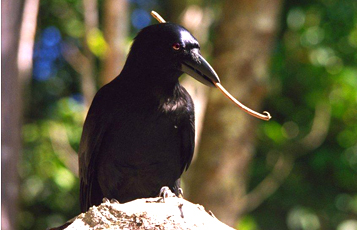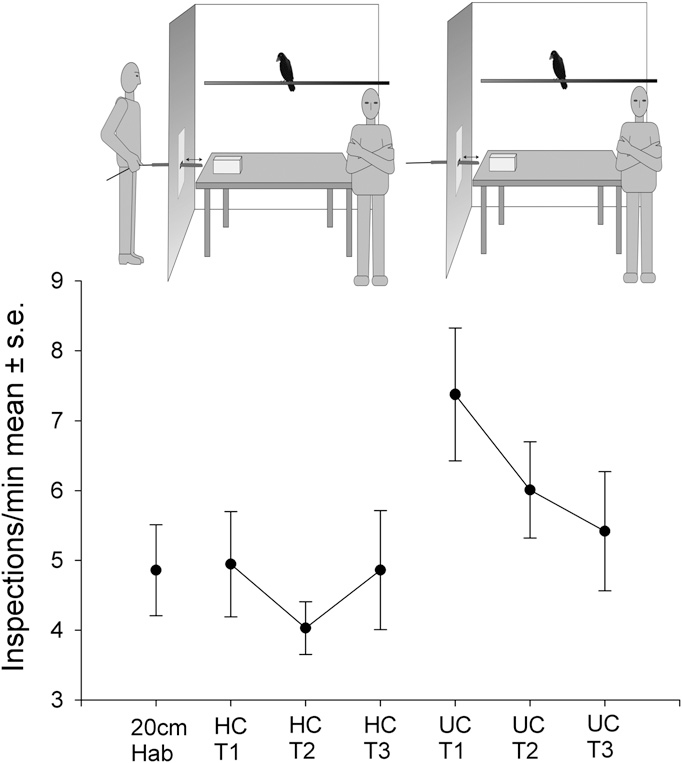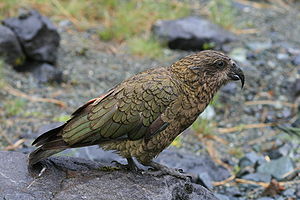New Caledonian crows - smarter every time we look at them.
A fascinating new piece of research was published a couple of days ago in the journal Proceedings of the National Academy of Sciences (or PNAS for short).

It shows that New Caledonian crows are capable of a cognitive feat previously only thought to be doable by human beings - the ability to reason about a hidden causal agent (in this case someone behind a sheet). Inference, in other words.
As the (open access/free) paper explains in its opening sentences:
The ability to make inferences about hidden causal mechanisms underpins scientific and religious thought. It also facilitates the understanding of social interactions and the production of sophisticated tool-using behaviors. However, although animals can reason about the outcomes of accidental interventions, only humans have been shown to make inferences about hidden causal mechanisms.
Alex Taylor of the University of Auckland’s School of Psychology (hooray NZ!) and colleagues have shown, however, that we’re NOT the only creatures capable of doing it.
They took eight Caledonian crows - very clever birds, admittedly, who’ve previously been shown to be capable of making and using tools - and showed two series of events. Before the events, the crows had been given some experience with extracting food from a box using a tool.
Both events involved a sheet, and a stick which moved.
The first set of events: the Hidden Causal Agent (HCA)
In the first set of events, the crows were able to watch as a person (of the human sort) walked behind a blue sheet that was hanging up near to a box containing food. The box had been set up so that the crows had to turn their heads away from watching the sheet in order to get their food out.
Once the human had walked behind the sheet, the crows saw the stick poking out from behind it move, making motions towards the food box, and then they saw the human leave again. ‘Meh’, one could imagine the crows thinking, ‘makes total sense. Fudz om nom nom.’
And that’s what they did - they came down to the food box, picked up a tool and extracted their food, giving nary a glance towards the sheet.
Ah, yes. There was also a second person who came into the room with the first, stood in the corner 1.5m from the sheet with closed eyes and hands held crossed in front of their body. This second person did nothing, and then left with the first person.
The second event: the Unknown Causal Agent (UCA)
In the second set of events, they saw the stick move in the same way without someone walking behind, or walking away from, the sheet. A ghost stick!*
As in the first event, there was also a second person who did nothing at all and then left.

And so?
The experiment had been designed so that this stick stimulus would be a new experience for the crows, and so probably something they’d intrinsically distrust (or not like, at the very least)**.
Also, they were unlikely to like the stick movement, as it was waggling in the space where they’d put their heads when extracting food from the box. When they were extracting food, it’d mean they couldn’t monitor whether the stick was moving, because it would be behind them.
Which would mean they’d need to minimise as far as possible the perceived risk of being smacked upside the head by said stick while they were getting their food.
There were two ways to do this:
1. Be very cautious about the stick after seeing it move in the HCA condition.
This caution would then recede a little each time the crows extracted their food without being hit by the stick (which would obviously never actually happen, as researchers are not apt to hit research animals with sticks***).
2. Predict the stick’s movement by reasoning why it was moving in the first place.
If the crows made the causal link in the first event between human behind sheet and moving stick, then they’d infer that, with no human going behind said sheet, no stick would move.
In the UCA condition, however, such causal reasoning would lead them to the conclusion that the stick could move on its own, and that they’d best be careful even with no person in the room.
Which is what one would see if they were following the second means of minimising their chance of stick-related head injury.
Caution, in this experiment, was measured by seeing how many times the crows inspected the sheet rather and abandoned probing for food (leaving the tool inserted) from the box.
Results
Well, I’ve rather given it away but yes, the crows were far more cautious after the UCA condition than they were after the HCA. In the UCA condition (each event was repeated three times, I should mention), at least half of the crows abandoned probing for food in favour of exploring the sheet - something they didn’t do for HCA condition, even on the first time when they wouldn’t have seen a wobbling stick before.
And what may _we_ infer from this?
According to the paper,
Darwin himself speculated that a dog barking at a parasol
moving slightly in a breeze might be because the dog reasoned
that “movement without any apparent cause indicated the presence
of some strange living agent”
They go on to say that there is evidence that crows react differently to the presence of hunters who stay in, as opposed to leave, hides.
The scientists reason that their results suggest that complex cognition may underpin such behaviour, and that the ability to infer why an inanimate object is moving could be highly adaptive in many conditions. They make the example of understanding why a part of the treetop canopy is moving - is it leaves themselves, or something else (other than the wind) which is moving them?
Which might mean that the ability to infer is far more widely-spread amongst members of the animal kingdom than we had thought. Given that there had been no previous research which sought to test this by recreating possible ecological situations, we cannot be sure that the lack of evidence that animals can’t do it hasn’t been because we simply weren’t doing the right sorts of experiments.
On the other hand, point out the paper’s authors, it could be that additional selective pressures are needed to ‘scaffold’ the development of this ability, such as tool use, tool manufacture, extractive foraging and complex social interactions.
So next step? Try this sort of experiment with other sorts of animals who engage in different sorts of social behaviour, tool use and experience different types of predation. It will certainly help understanding how the ability to infer evolved.
I’d like to see how Kea stack up :)

—-
Did you know:
Inference is something that human babies generally start showing at 7-10 months of age, when they show surprise at a bean bag which is thrown from behind a screen, after which the screen is lifted to show that there is just an inert object behind it rather than a causal agent (such as a hand).
—
* In reality, the stick was moved by a string pulled on by one of the experimenters. Said string could be pulled on from someone behind the sheet, or from someone outside the room. See? Ghost stories generally have plausible explanations :)
** Neophobia
*** I can just _imagine_ the ethics board meeting on that one…
—-
Reference
Taylor, A. H. et al (2012). New Caledonian crows reason about hidden causal agents Proceedings of the National Academy of Sciences DOI: 10.1073/pnas.1208724109. The article is open access.